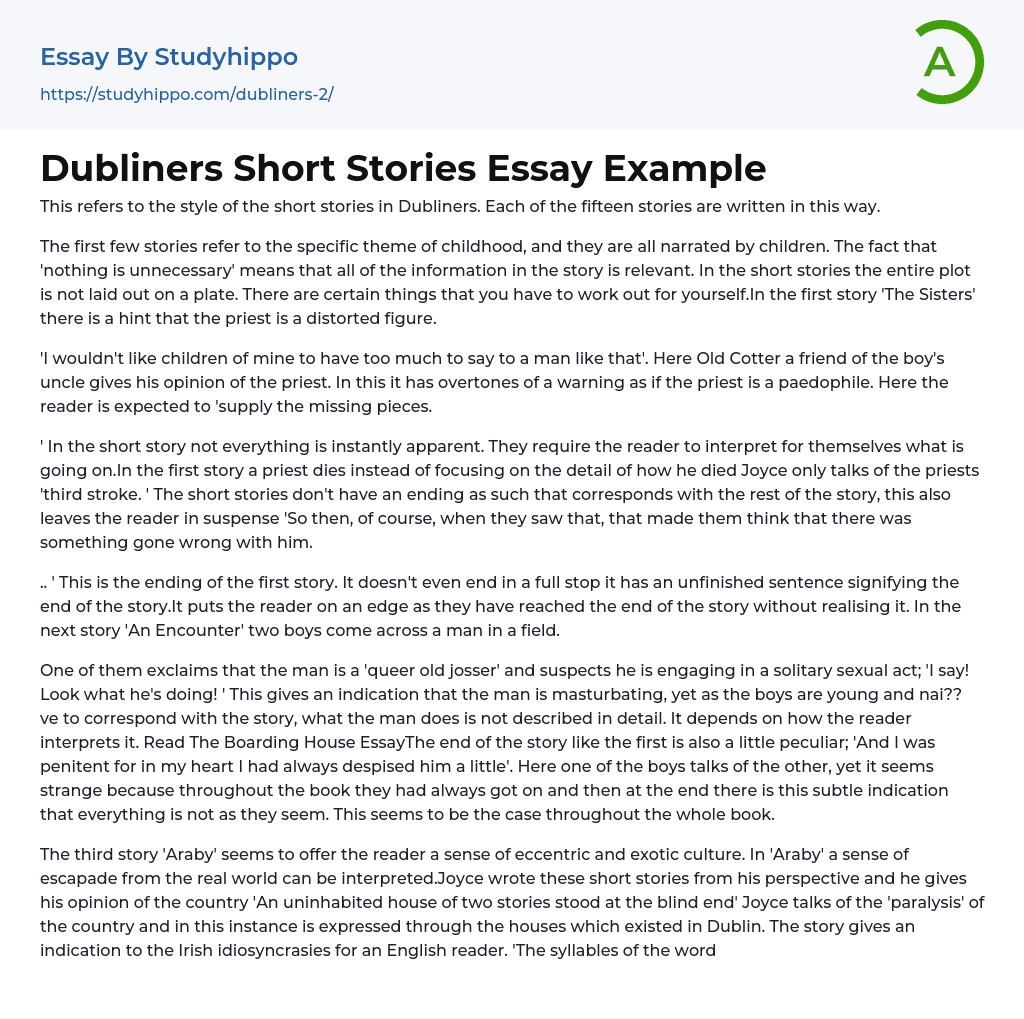This method is utilized throughout Dubliners for crafting the style of its short stories. All fifteen narratives are composed in this fashion.
All the initial stories revolve around childhood and are told from a child's perspective. The key takeaway is the value of every piece of information in each tale. The stories do not simply present the entire plot, and readers must deduce certain aspects themselves. For instance, the first story 'The Sisters' alludes to the distorted nature of the priest.
'I wouldn't want my children talking to someone like that,' states Old Cotter, a friend of the boy's uncle, as he shares his opinion of the priest. The statement carries a warning, suggesting that the priest may be a pedophile, leaving the reader to fill in the gaps.
Short stories demand interpretation from readers as they
...do not provide immediate clarity. "Third stroke" is the only detail Joyce offers about the death of a priest in one story. Additionally, short stories often lack conclusive endings, leaving readers in suspense, as seen in the example where observers suspect something has gone wrong with someone.
'This marks the conclusion of the initial tale. Instead of concluding with a period, an incomplete sentence denotes the finale, leading the reader to unknowingly reach the end. The following story, 'An Encounter', involves two boys encountering a man in a field.'
In the story, one of the young boys exclaims that the man they see is a 'queer old josser' and suspects he is engaging in masturbation. However, due to the young age and naivety of the boys, the details of the man's activity are not described. It is left to the interpretation
of the reader. The conclusion of the story is also unusual as one of the boys confesses to despising the other, despite their previously good relationship. This subtle indication that all is not as it seems throughout the book.
Read The Boarding House Essay.
In 'Araby', Joyce presents an exotic culture that offers the reader a sense of adventure and escape from reality. The story reflects Joyce's perspective on the state of the country, where he describes the paralysis through the depiction of houses in Dublin. This serves to highlight the Irish idiosyncrasies for an English audience. Despite the allure of an Eastern enchantment, the reality of 'Araby' is revealed as a mere church bazaar.
The book's stories are characterized by partiality and a deeper meaning than superficial appearances suggest. It may seem as if the stories are incomplete, but this is due to misinterpretation. Every aspect included in the story is necessary and bears relevance to the overall narrative, requiring readers to reread in order to fully understand.
Joyce utilizes partiality to suggest that there are varying viewpoints towards a certain subject matter, contingent upon the reader's interpretation.
- Book Summary essays
- Metaphor essays
- Reader essays
- Rhyme essays
- Literary devices essays
- Villain essays
- Books essays
- Genre essays
- Literary Criticism essays
- Writer essays
- Protagonist essays
- Simile essays
- Poem essays
- Book Report essays
- Book Review essays
- Greek Mythology essays
- Plot essays
- Tragic Hero essays
- Coming of Age essays
- Play essays
- Rhetoric essays
- Rhetorical Question essays
- Translation essays
- Understanding essays
- Reason essays
- Character essays
- Letter essays
- American Literature essays
- Literature Review essays
- Utopia essays
- Poetry Analysis essays
- Dante's Inferno essays
- Between The World and Me essays
- Incidents in The Life of a Slave Girl essays
- Flowers for Algernon essays
- Myth essays
- Everyday Use essays
- Boo Radley essays
- Genesis essays
- Richard iii essays
- Alice in Wonderland essays
- On the road essays
- Ozymandias essays
- The Nightingale essays
- Holden Caulfield essays
- Animal Farm essays
- 1984 essays
- A Hanging essays
- Shooting An Elephant essays
- A Tale Of Two Cities essays




